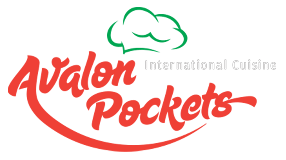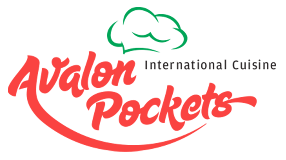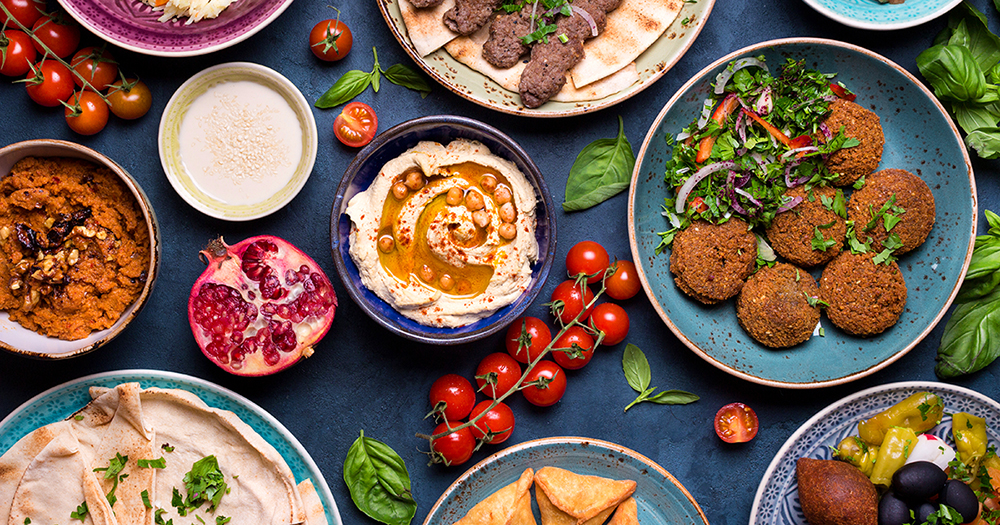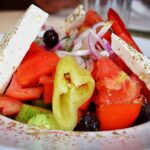Most health experts are now saying that Middle Eastern Food is the second Mediterranean diet and today, we will find out why.
The COVID-19 pandemic has dramatically increased obesity, alcoholism, depression, suicide, and a plethora of other health conditions based on scientific data. Despite the gravity of the situation, all of this can be treated or prevented with healthy diet choices and exercise. Maintaining a good health must remain your top priority to fight any illnesses even though your regular routines, schedules, and norms have been interrupted. Your best chance at success would be the Mediterranean diet. Since the world was made aware about the amazing health benefits of the Mediterranean diet, interest in it has been at its highest and with fewer deaths occurring in Mediterranean countries in terms of CVD (coronary heart disease), especially in places like Greece and Italy compared to U.S. and northern Europe, its popularity just keeps getting stronger. There are also plenty of studies published in peer-reviewed journals about the Mediterranean diet and its link to the reduction of CVD risk factors. Due to this fact, the Dietary Guidelines for Americans chose it to become one of their most favored eating patterns that enhances people’s health and even the prevention of chronic disease.
But what exactly does the Mediterranean diet look like?
Depending on which region of the Mediterranean Basin you get your recipes from, it can take many forms. For example, the Italians have a different diet pattern than the Greeks and the Greeks also have a different eating pattern compared to the Lebanese people. However, some of their diet patterns are common across their cultures, in fact; one might say that these recipes have overlapping reach among Mediterranean countries. But did you know that Middle Eastern Food is also another version of the Mediterranean diet?
The Mayo Clinic says that the main components of the Mediterranean diet include:
- Religiously eating vegetables, fruits, whole grains, and healthy fats on a daily basis
- Fish, poultry, beans, legumes, and eggs to be consumed at least once a week
- Moderate portions of dairy products
- Consume red meat once a month and in small portions only (maximum of 4 times a month)
- Consumption of healthy fats from olive oil, nuts, and seeds should also be done daily
- Sharing meals with family and friends and being physically active are also important elements of the Mediterranean diet.
The Middle Eastern Interpretation of the Mediterranean Diet (Middle Eastern Food)
In the Mediterranean region the Greeks enjoy their variety of seafood from calamari to swordfish, while the Italians love their pasta; the Arabs of the Levant also have their own unique culinary collection, which is surprisingly very similar to the principles of the Mediterranean diet.
Below are the components of the Middle Eastern Food:
Fruits and Vegetables
Arabs love to eat fruits and vegetables (whatever is available for the season) and form the foundation of the Middle Eastern Food. We’ve listed them down for you to discover.
Vegetables:
- Arugula
- Artichokes
- Dandelion greens
- Garlic
- Onions
- Cucumbers
- Eggplant
- Jute leaves
- Okra
- Spinach
- Potatoes
- Zucchini
- Green beans
- Cabbage
Fruits:
- Mulberries
- Figs
- Stone fruits like peaches
- Apricots and plums
- Apples
- Melons
- Citrus fruits (especially lemons)
- Persimmons
- Dates
- Olives
- Avocados
- Tomatoes
- Pomegranates
- Grapes
- Carob
Healthy Fats
Much like their European counterpart, Middle Eastern Food also includes healthy fats its ingredients. They’re eaten instead of saturated and trans fats, which contribute to heart disease. As it is with the Mediterranean diet, olive oil is also the primary source of fat for Middle Eastern Food. Olive oil contains monounsaturated fat, which has been proven to reduce LDL (low-density lipoprotein) or “bad” cholesterol in the body. Another source of monounsaturated fats are nuts and seeds, which Arab people love to eat on a daily basis.
Healthy Fat List:
- Olive oil
- Olives
- Ghee
- Avocados
- Nuts like almonds
- Pistachios
- Cashews
- Walnuts
- Pine nuts
- Sesame
- Pumpkin seeds
Seafood
Fish contains omega-3 fatty acids which is a type of polyunsaturated fat that may reduce inflammation in the body and some Arab countries near the Mediterranean Sea also incorporate fish in their diet. Omega-3 fatty acids also helps prevent stroke and heart failure by decreasing the amount of triglycerides in the blood thus reducing blood clotting.
Fish and Seafood List:
- Mackerel
- Herring
- Sardines
- Tuna
- Salmon
- Trout
Poultry, Dairy, and Other Meats
Middle Eastern people on average consume plenty of poultry and eggs during the weekdays, and save red meat for the weekends and special occasions. Lamb meat is the number 1 choice when it comes to red meat in the Middle Eastern Food and among the parts that Arabs love include the nose to tail organs like spleen, liver, and kidneys. Arabs consume dairy in the form of feta or goat cheese to flavor salads, labneh (kefir cheese) for breakfast, and Greek yogurt as a regular side dish to rice-based dinners – and they do so in moderation. For special occasions, they use goat’s milk like Kunafeh or Katayef to add to desserts.
Poultry, Dairy, and Other Meats List:
- Chicken
- Cornish hens
- Lamb
- Goat
- Beef
- Spleen
- Kidney
- Tripe
- Liver
- Eggs
- Goat cheese
- Kefir cheese
- Feta cheese
- Greek yogurt
Grains and Legumes
Emphasis on legumes like chickpeas for hummus, and lentils for soups and dishes like Mujaddara is what distinguishes the Middle Eastern Food from the standard Mediterranean diet. Arabs are not so much into pasta and other starches, but instead they prefer grains like bulgur wheat, barley, wheat berries, and freekeh.
Grains and Legumes List:
- Chickpeas
- Lentils
- Bulgur wheat
- Barley
- Wheat berries
- Freekeh
- Rice
The Diet Patterns of Greeks and Middle Easterners
Going back in history, the Mediterranean diet was actually discovered during the post-World War II era, and then 40 years later the mainstream media, picked up the news from scientists about how good this diet is for the human body, spread the news across the world reaching as many people as they possibly could. Fast forward to the 21st century, about half of the world knows what the Mediterranean diet is by now and this knowledge is still being proliferated more and more. Researchers find low incidences of chronic disease and high life-expectancy rates attributed to the populations who consumed a traditional Mediterranean diet. It’s also surprising to find out that Middle Eastern Food follows a very similar pattern with the Mediterranean diet, especially since some Middle Eastern countries also lie near the Mediterranean Sea.
The Mediterranean Basin
If one is to understand the Mediterranean diet, then one must first learn about the countries that lie at the Mediterranean Sea shorelines. The diet seems to be associated with areas in the Mediterranean Basin where olive oil cultivation is prevalent. The Mediterranean diet was first discovered in places like southern Italy and other Mediterranean regions in which olive oil was the principal source of dietary fat back in the early 1960s. The olive tree, as it seems, not only has adapted to the regional climate of long, very hot, dry summers and mild, damp winters, but also became the most valuable plant in the region because of its amazing health benefits.
Interestingly this eating pattern seems to have found its way into some Arab countries whose coastlines face the Mediterranean Sea like Lebanon, Israel and Syria. New evidence shows that the Mediterranean diet may have been proliferated as far inland as Iran, Iraq and Saudi Arabia for which it has formed into what is now known as the Middle Eastern Food. The lands surrounding the Mediterranean Sea contain some of the oldest cultures on Earth. Due to the various empires that have risen and fallen, cross-cultural exchanges took place over the centuries. When empires opened commercial trade routes by sea over 2,000 years ago, it allowed Greek, Roman, Phoenician, Carthaginian, Arab, and Oriental products and traditions to intermix, mutually evolved and amalgamated into what is now known as the Mediterranean diet. So by default there is no such thing as a single Mediterranean diet, as it is an incorporation of multiple cuisines contributed by many different cultures.
Traditional Eating Habits
Mediterraneans traditionally eat olives, fish, lamb, wheat, rice, chick peas and other legumes, pistachios, dates, cheese, and yogurt. They often eat bread made from whole grains, instead of mash potatoes that Americans eat, or rice which is a popular pair for viands in Asian countries. Middle Eastern Food on the other hand prefers rice, but it still ranks second in the health scale when compared to the Mediterranean diet.
Traditional food consumption includes the following:
- Dairy Products – A lot of their dairy products are usually consumed in fermented forms, like cheese and yogurt. For desserts and puddings, whole milk is added to enhance the flavor. Mediterraneans’ favorite cheese is feta cheese which is traditionally made of sheep or goat’s milk.
- Meats – All across the Mediterranean region lamb is the most popular choice of meat. Pork, on the other hand, is shunned by Muslims and Jews as it is forbidden in their religion and only the Christians eat pork meat. Many Middle Easterners are also not fond of combining shellfish or dairy products with any meal and they usually eat it separately. Other common foods include kosher beef, kosher poultry, lox (brine-cured cold-smoked salmon, much of which is slightly saltier than other smoked salmon), and sardines. Legumes such as black beans, chick peas (garbanzo beans), lentils, navy beans, fava beans, and red beans are used in many dishes.
- Breads and Cereals – Mediterraneans do eat wheat (made into bread or other edible food) or rice and are often paired with other meals. Pita and matzoh (unleavened bread) are also common bread varieties. Filo dough, commonly used to make baklava, is also used to create other delicious dishes in the Mediterranean diet.
- Fruits – When fresh fruit is not available, days-old fruits are made into jams and compotes (a cooked preparation of fruit in syrup). Lemons and concentrated lemon juice are commonly used for flavoring.
- Vegetables – The most favorite vegetables of the Mediterraneans and the Arabs are eggplant and potatoes. They also prefer to consume fruits and vegetables raw or mixed in a salad. Vegetables are often stuffed with rice or meats. They use olive oil to cook just about everything and green and black olives are also a key ingredient in most of their dishes. Olive oil is common between the Mediterranean diet and Middle Eastern Food.
Food Preparation and Storage
The European-Mediterraneans and Middle Eastern Arabs commonly cook their meats by grilling, frying, grinding, and stewing. Whenever there is a special occasion, they would roast a whole lamb or just its leg to serve to the guests. Spices and seasonings are essential in the preparation of Middle Eastern Food. Dill, garlic, mint, cinnamon, oregano, parsley, leek, and pepper are among the common spices and herbs you will find in Middle Eastern Food.
Ever since Islam proliferated in the Middle East, majority of the population in those countries (e.g. Turkey, Syria, and Lebanon) are predominantly Muslim. Eating halal is obligatory for every Muslim. Halal means “lawful” or “permitted,” in the Arabic language and is strictly enforced under Islamic law pertaining to a Muslim’s diet. Cows, sheep, goats, deer, moose, chickens, ducks, and game birds are considered halal by Islamic tradition; however, they have to be slaughtered according to Islamic method known as “zabihah,” in order to be considered “clean” enough for consumption. Such is the Middle Eastern Food. Halal foods are foods that are:
- Free from unlawful animal components or ingredients – whether taken or extracted from them or ingredients that contradicts Islamic law.
- Prepared, manufactured, processed, or stored using any apparatus, equipment and/or machinery that has been cleansed in accordance with Islamic law.
- Not contaminated with anything considered unclean by Islamic law when they were prepared or processed.
Present-Day Eating Habits
The Mediterranean region these days is nothing like it was 6 decades ago back when the Mediterranean diet was first discovered. Instead, most things are modernized and dull health wise. Globalization pushed the Mediterraneans to produce agriculture loaded with hazardous chemicals for foreign trade and not for healthy purposes. Meanwhile the countries of North Africa and the Middle East struggle the most with modernization problems. This is because of the rapid urbanization of their areas which has led to the loss of vital agricultural land. As a result, they are also forced to depend more on costly food imports from outside the region.
The eating patterns of the people in the Mediterranean Basin have significantly changed over the years due to modernization. The economy, environment, society and culture, disasters (i.e., war, drought), the expansion of food industries, and advertising campaigns promoting certain foods (i.e., soda, candy bars) are among the most common factors that affect the traditional dietary customs of the region. The traditional Mediterranean diet or the Middle Eastern Food known for their excellent health benefits are slowing eroding away and are being replaced by the ever-growing fast-food restaurant chains. There ought to be a movement driving people to return to their traditional nutritional sustenance and reject processed food.

Culture
Mediterranean and Middle Eastern culture is centered on a strong patriarchal family. Unfortunately, due to the introduction of Western political correctness (among other things) this cultural value has diminished in recent years; however, family ties are still strong. Customs and family traditions influence nutrition greatly.
The Mediterraneans and Middle Eastern people consider food as an integral part of family celebrations, special days of honor, and festivals. In Israel, for example, the Jews still practice the kosher dietary laws that are believed to have been handed down from their great prophet, Moses in the 13th century B.C.E. This law gives specific instructions on how to select, prepare and consume food. Meanwhile the Jewish laws of kashrut, or keeping kosher, determines which foods are kosher and which are non-kosher.
Islam and Eastern Orthodox religions, which influence the kinds of food chosen and how the foods are combined prior to consumption, are the primary religions observed by Mediterranean and Middle Eastern cultures. Muslims also fast for 12 hours while the sun is visible during the holy month of Ramadan and only eat food at night. Muslims also do not eat foods that are considered haram (forbidden in Arabic tongue) like pork, and reject meat that is not halal (slaughtered without mentioning Allah’s name). By Islamic law, Muslims are prohibited from drinking alcoholic beverages or foods that include alcohol in its ingredients. This is one of the clear differences between the Mediterranean diet and Middle Eastern Food, as wine is an essential part to the cuisines of the Greeks and other Mediterranean cultures. There is a high incidence of lactose intolerance among the people of the Middle East, and this is why they rarely drink fresh milk.
Common Foods Between the Mediterranean Diet and Middle Eastern Food
- Hummus
- Falafel
- Tabouleh
- Moutabal/Baba Ghanoush
- Fattoush
- Shawarma
- Dolma
- Kebab
- Baklava
- Kofta








3 Responses
Love it!
All the food mentioned here looks so delicious!
POULTRY, DAIRY, AND OTHER MEATS LIST Chicken, cornish hens, lamb, goat, beef, spleen, kidney, tripe, liver, eggs, goat cheese, kefir cheese, feta cheese, Greek yogurt What really differentiates the Middle Eastern diet from the standard Mediterranean diet is its emphasis on legumes like chickpeas for hummus, and lentils for soups and dishes like Mujaddara. Arabs favor grains like bulgur wheat, barley, wheat berries, and freekeh over pasta and other starches.